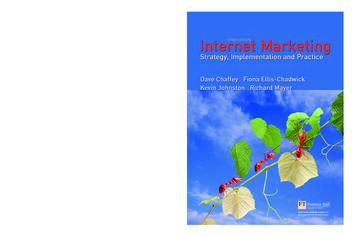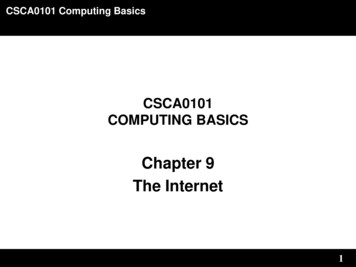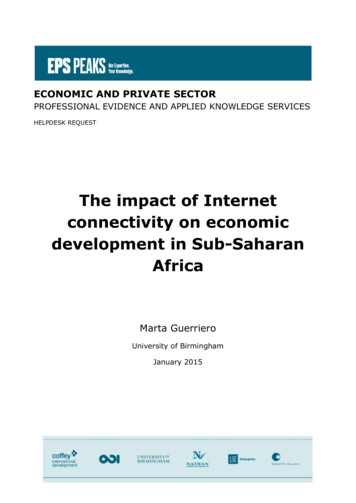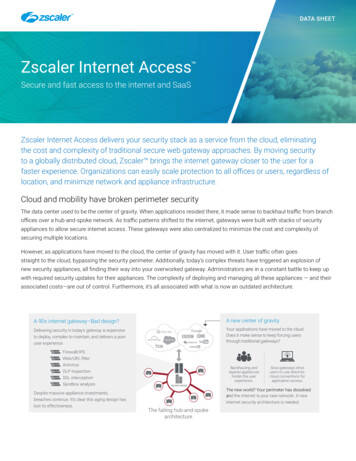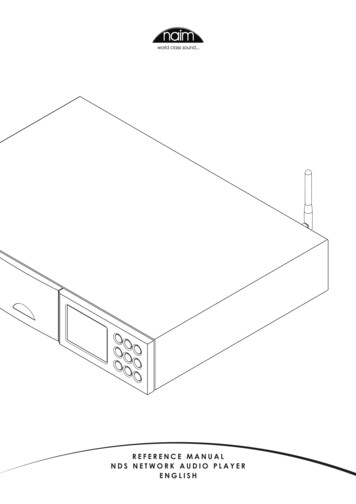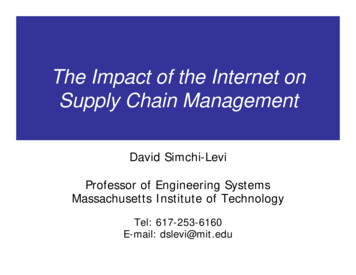
Transcription
The Impact of the Internet onSupply Chain ManagementDavid Simchi-LeviProfessor of Engineering SystemsMassachusetts Institute of TechnologyTel: 617-253-6160E-mail: dslevi@mit.edu
Outline Introduction to Supply ChainManagement Internet Based Supply Chain Strategies– a new business model e-Business Opportunities Internet Based B2B Strategies Copyright 2001 D. Simchi-Levi
emandcenterssinksSupplyInventory ationcostsInventory &warehousingcostsTransportationcosts
Supply Chain Management Definition:Supply Chain Management is primarily concernedwith the efficient integration of suppliers, factories,warehouses and stores so that merchandise isproduced and distributed in the right quantities, tothe right locations and at the right time, and so as tominimize total system cost subject to satisfyingservice requirements. Notice:– Who is involved– Cost and Service Level– It is all about integration Copyright 2001 D. Simchi-Levi
Conflicting Objectives in the SupplyChain1. Purchasing Stable volume requirements Flexible delivery time Little variation in mix Large quantities2. Manufacturing Long run production High quality High productivity Low production cost Copyright 2001 D. Simchi-Levi
Conflicting Objectives in the SupplyChain3. Warehousing Low inventory Reduced transportation costs Quick replenishment capability4. Customers Short order lead time High in stock Enormous variety of products Low prices Copyright 2001 D. Simchi-Levi
Order SizeThe Dynamics of the Supply butor OrdersOrdersRetailerRetailer OrdersOrdersProductionProduction PlanPlanTimeSource: Tom Mc Guffry, Electronic Commerce and Value Chain Management, 1998 Copyright 2001 D. Simchi-Levi
Order SizeThe Dynamics of the Supply ion PlanPlanTimeSource: Tom Mc Guffry, Electronic Commerce and Value Chain Management, 1998 Copyright 2001 D. Simchi-Levi
We Conclude:In Traditional Supply Chains . Order Variability is amplified up thesupply chain; upstream echelons facehigher variability. What you see is not what they face. Copyright 2001 D. Simchi-Levi
The Bullwhip EffectP&GRetailersCustomers Copyright 2001 D. Simchi-Levi
Consequences . Single retailer, single manufacturer.– Retailer observes customer demand,Dt.– Retailer orders qt from manufacturer.DtRetailerqtLManufacturer Copyright 2001 D. Simchi-Levi
Consequences . Increased safety stock Reduced service level Inefficient allocation of resources Increased transportation costs Copyright 2001 D. Simchi-Levi
The Future is Not What it Used to Be A new e-Business Model– Reduce cost– Increase Profit– Increase service level– Increase flexibility Copyright 2001 D. Simchi-Levi
Reality is Different . Amazon.com Example–––––4 year history1st Internet purchase for most people1996: 16M Sales, 6M Loss1999: 1.6B Sales, 720M Loss2000: 2.7B Sales, 1.4B Loss Peapod Example––––Founded 1989140,000 members, largest on-line grocerRevenue tripled to 73 million in 19991st Quarter of 2000: 25M Sales, Loss: 8M Copyright 2001 D. Simchi-Levi
Reality is Different . Dell Example:– Dell Computer has outperformed the competitionin terms of shareholder value growth over theeight years period, 1988-1996, by over 3,000%(see Anderson and Lee, 1999) Copyright 2001 D. Simchi-Levi
The e- Business Model e-Business is the process of redefining oldbusiness models, using Internet technology,so as to improve the extended enterpriseperformance– e-commerce is part of e-Business– Internet technology is the driver of the businesschange– The focus is on the extended enterprise: Intra-organizational Business to Consumer (B2C) Business to Business (B2B) Copyright 2001 D. Simchi-Levi
A new Supply Chain Paradigm A shift from a Push System.– Production decisions are based on forecast to a Push-Pull System Copyright 2001 D. Simchi-Levi
From Make-to-Stock Model .SuppliersAssemblyConfiguration Copyright 2001 D. Simchi-Levi
Demand Forecast The three principles of all forecastingtechniques:– Forecasts are always wrong– The longer the forecast horizon the worst is theforecast– Aggregate forecasts are more accurate The Risk Pooling Concept Copyright 2001 D. Simchi-Levi
A new Supply Chain Paradigm A shift from a Push System.– Production decisions are based on forecast to a Push-Pull System Copyright 2001 D. Simchi-Levi
Push-Pull Supply ChainsPUSH STRATEGYPULL STRATEGYPush-Pull Boundary Copyright 2001 D. Simchi-Levi
A new Supply Chain Paradigm A shift from a Push System.– Production decisions are based on forecast to a Push-Pull System– Parts inventory is replenished based onforecasts– Assembly is based on accurate customerdemand Copyright 2001 D. Simchi-Levi
.to Assemble-to-Order ModelSuppliersAssemblyConfiguration Copyright 2001 D. Simchi-Levi
Demand Forecast The three principles of all forecastingtechniques:– Forecasts are always wrong– The longer the forecast horizon the worst is theforecast– Aggregate forecasts are more accurate The Risk Pooling Concept Copyright 2001 D. Simchi-Levi
Business models in the BookIndustry From Push Systems.– Barnes and Noble .To Pull Systems– Amazon.com, 1996-1999 And, finally to Push-Pull Systems– Amazon.com, 1999-present 7 warehouses, 3M sq. ft., Copyright 2001 D. Simchi-Levi
Direct-to-Consumer:Cost Trade-OffCost ( million)Cost Trade-Off for BuyPC.com 20 18 16 14 12 10 8 6 4 2 0Total CostInventoryTransportationFixed Cost0510Number of DC's15
Business models in the GroceryIndustry From Push Systems.– Supermarket supply chain .To Pull Systems– Peapod, 1989-1999 Stock outs 8% to 10% And, finally to Push-Pull Systems– Peapod, 1999-present Dedicated warehouses Stock outs less than 2% Copyright 2001 D. Simchi-Levi
Business models in the GroceryIndustry Key Challenges for e-grocer:– Transportation cost Density of customers– Very short order cycle times Less than 12 hours Copyright 2001 D. Simchi-Levi
Less than 300,000 shoppersNumber ofcustomersAverageorderDelivery chargesWebvan21000 71Peapod140000 120 4.95 for 50free for 50 7.95 per orderHomeGrocer.com50000 110NetGrocer.com60000 70ShopLink.com3300 98 9.95 75 freefor 75 2.99 for 50 4.99 for 50 25 monthlyStreamline.com3400 100 30Source: D. Ratliff Copyright 2001 D. Simchi-Levi
e-Business in the Retail Industry Brick-&-Mortar companies establish Virtualretail stores– Wal-Mart, K-Mart, Barnes and Noble Use a hybrid approach in stocking– High volume/fast moving products for localstorage– Low volume/slow moving products for browsingand purchase on line Channel Conflict Issues Copyright 2001 D. Simchi-Levi
E-Fulfillment Requires a NewLogistics InfrastructureTraditional Supply Chaine-Supply ChainSupply Chain StrategyPushPush-PullShipment TypeBulkParcelInventory FlowUnidirectionalBi-directionalSimpleHighly ComplexDestinationSmall Number of StoresHighly Dispersed CustomersLead TimesDependsShortReverse Logistics Copyright 2001 D. Simchi-Levi
Matching Supply Chain Strategieswith rFurnitureIVIIIBooks & CDsGroceryLLPullHDelivery costUnit pricePush Copyright 2001 D. Simchi-Levi
Locating the Push-Pull Boundary Copyright 2001 D. Simchi-Levi
Organization Skills NeededRawMaterialsCustomersPushPullCost MinimizationService LevelResource AllocationResponsivenessLong Lead TimesShort Cycle Times Copyright 2001 D. Simchi-Levi
The Push-Pull Interface Integrate the Push and the Pull portionof the supply chain– Order Fulfillment manages the Pull portionof the supply chainService Level– Tactical Planning manages the Push portionof the supply chainCost– Demand Planning is the interface betweenthe Pull and the Push portions Copyright 2001 D. Simchi-Levi
Push-Pull Supply ChainsPUSH STRATEGYTactical planningPULL STRATEGYDemandplanningFulfillment Copyright 2001 D. Simchi-Levi
e-Business Opportunities: Reduce Facility Costs– Eliminate retail/distributor sites Reduce Inventory Costs– Apply the risk-pooling concept Centralized stocking Postponement of product differentiation Use Dynamic Pricing Strategies toImprove Supply Chain Performance Copyright 2001 D. Simchi-Levi
Dynamic Pricing: Trade-Offs Allocation of capacity to current orfuture demand High price and low demand versus lowprice and high demand Balance between production cost andinventory holding cost Copyright 2001 D. Simchi-Levi
When does dynamic pricing matter? Tightly constrained capacityVariability in demandVariability in capacityProduct proliferationMarket segmentationSource:Chan,Simchi-Levi and Swann (2000), Using Flexible Pricing to ImproveSupply Chain Performance Copyright 2001 D. Simchi-Levi
Impact of Changes in Demand As the variability in demand increases, the benefit of dynamic pricing increasesAs capacity becomes more constrained, the benefit of dynamic pricing increasesImpact of Demand Changes on Dynamic Pricing Benefitwhen Capacity is Constant25.0%% Benefit20.0%15.0%Cap 0.5 * Opt Base Dem10.0%Cap 0.75 * Opt Base DemCap Opt Base Dem5.0%0.0%00.20.40.60.8Coefficient of Var (Cap/Dem*) Copyright 2001 D. Simchi-Levi
Other Potential Impacts of DynamicPricing Reduction of variability in sales orproduction schedule Increase in average sales Reduction of inventory Reduction in average (or weightedaverage) price Copyright 2001 D. Simchi-Levi
Internet Based B2B Strategies1) FreeMarkets Online: A Case Study2) B2B Strategies3) B2B Pitfalls1. FreeMarkets Online, Harvard BusinessSchool, 9-598-109 Copyright 2001 D. Simchi-Levi
FreeMarkets Online FreeMarkets is an online market making firm thatenabled industrial buyers to link up with theirpotential suppliers in a live electronic bidding The end result of such interaction among a networkof suppliers was procurement cost savings of about15% for the buyers The company was founded in 1995 and was on theverge of breaking even in 1998– It was expecting to receive commissions and fees of nearly 6 million for arranging procurement of 200 million worthof industrial components and parts Copyright 2001 D. Simchi-Levi
The Move to B2B Commerce Copyright 2001 D. Simchi-Levi
B2B is Huge.2003 1.3 02 843B1998 43B1999 109B2001 499B2000 251BSource: Forrester Research, Inc. Copyright 2001 D. Simchi-Levi
But sShippingShippingFood2003 1.3 TrillionAerospaceFinancialServicesMotor VehiclesUtilitiesHealthcareComputing &Electronics Copyright 2001 D. Simchi-Levi
Highly Fragmented Most product categories are highly fragmented, with numeroussuppliers each offering different level of quality, service andpricing options Buyers incur significant cost in the actual purchase process– A buyer must invest internal resources to manage the process ofcollecting, analyzing and acting upon all the information in themarket– In addition to purchase price companies spend over 10% inadditional procurement costs On the suppliers side, there are significant costs in using themanufacturing reps– These commissions range from 4% to 7% of purchase price Copyright 2001 D. Simchi-Levi
How Does FreeMarkets Online CreateValue for its Customers? Consulting/Purchase outsourcing– Putting together specs, drawings, lot sizes, documentationand RFQs– Identifying potential savings opportunities– Identifying and qualifying suppliers– Educating and training buyers– Conducting the Competitive Bidding Event (CBE)– Providing post bid analysis and support Copyright 2001 D. Simchi-Levi
How Does FreeMarkets Online CreateValue for its Customers? Consulting/Purchase outsourcing Distribution Intermediary Copyright 2001 D. Simchi-Levi
Traditional B2B Trading ExchangesIndustrial BuyerManuf. Rep.Supplier 1Manuf. Rep.Supplier 2Manuf. Rep.Supplier 3 Copyright 2001 D. Simchi-Levi
Internet Based B2B TradingExchangesIndustrial BuyerFreeMarkets OnlineSupplier 1Supplier 2Supplier 3 Copyright 2001 D. Simchi-Levi
How Does FreeMarkets Online CreateValue for its Customers? Consulting/Purchase outsourcing Distribution Intermediary Network Enabler/Software Provider Copyright 2001 D. Simchi-Levi
To summarize the Value Proposition Value to Buyers– Elimination of the manufacturers’ reps– Access to information that is otherwisedifficult/expensive to assemble– Cost savings– Introduction to new suppliers– Another layer of quality assurance– An opportunity for the buyer to gain a betterunderstanding of its own needs– Outsourcing the RFQ process– Real time bidding Copyright 2001 D. Simchi-Levi
What are the Barriers for the buyers? Elimination of established relationships withthe suppliers and their representatives Elimination of manufacturing reps could resultin loss of convenience Potentially longer time lag until bid– CBE process needs to be integrated into themanufacturing process– Less suitable for time sensitive parts Copyright 2001 D. Simchi-Levi
What is the value to the suppliers? Less value for the suppliers– Commission costs fell from 7% to 2.5%– 15% drop in revenue for the suppliers Suppliers could benefit from lower sales,marketing and distribution costs and betterutilization of capacity Copyright 2001 D. Simchi-Levi
Which suppliers benefit from this model? Low cost, quality suppliers will benefit as theydrive competition out of the market– The FreeMarkets model would be beneficial forlarge more efficient suppliers It will also provide opportunities for a host ofsmall suppliers, especially if they are locatedoverseas Copyright 2001 D. Simchi-Levi
How should e-marketplaces charge?Can they build a solid profitable business? Many have been motivated by the desire tobuild scale quickly Transaction fees (typically paid by the sellers)– Sometimes the wrong party is charged– Buyers and suppliers resist paying Subscription fees (typically paid by the buyer)– Depends on a number of dimensions Licensing the software Copyright 2001 D. Simchi-Levi
The evolution of the value proposition Most e-marketplaces now recognize thatbeing a transaction hub alone is not sufficient– They are expanding their offering to includeinventory management and financial services(Zoho); supply chain planning (Covisint, e2open,Converge, TheSupply) Copyright 2001 D. Simchi-Levi
The evolution of the Industry The early evolution was led by dot.com stratups– Based upon charging transaction fees This was followed by consortium-based publicmarkets .– Covisint (automotive); Trade-Ranger (oil); Omnexus(chemicals); e2Open and Converge (high-tech) And private exchanges– Valuechain.Dell.com (Dell) and eHub (Cisco) Copyright 2001 D. Simchi-Levi
E-marketplace ExamplesIndependent VerticalExchanges (IVX)Consortia TradingExchanges (CTX)Independent HorizontalExchanges (IHX)Private TradingExchanges (PTX) Copyright 2001 D. Simchi-Levi
Private vs. consortium-based publicmarkets Consortium-based market places– Aggregate activities– Serve as a virtual co-op Not clear that industry consortia can hold together and build emarketplace in realistic timescale In a private exchange– Easier to integrate suppliers (Covisint has 20 suppliers after oneyear while eHub thousands)– Easier to build business intelligence into the exchange Dell uses its exchange to help coordinate the demand planning of thesuppliers Cisco uses its exchange to help coordinate production plans atsuppliers Copyright 2001 D. Simchi-Levi
Proposed Supplier/ProcurementManagement Model Indirect Procurement (operating input): Procurementof non-production items such as MRO (maintenance,repairs and operating) goods should be done throughMRO Hubs (MRO.com) or Big Supplier (Graingeronline catalogs) Specific Hubs Direct Procurement (manufacturing input):Procurement of production items (strategic sourcing)should be done through Company Specific Hubs Excess Inventory or Capacity of Uncertain Demand(spot purchases of direct and indirect materials)through on-line Auction Copyright 2001 D. Simchi-Levi
On-line Auction works best when Products are commodities or nearcommodities and can be traded sight unseen Trading volumes are massive relative totransaction costs Buyers and sellers are sophisticated enoughto deal with dynamic pricing Companies use spot purchasing to smooththe peak and valleys of supply and demand Logistics can be conducted by third party Demand and price are volatile Copyright 2001 D. Simchi-Levi
Company specific hubs work bestwhen Products are specialized, notcommodities The number of products is large Purchasing is done through prenegotiated contracts Long-term relationships are important Copyright 2001 D. Simchi-Levi
B2B Software Vendors Oracle (Indirect and Direct)i2 Technologies and Manugistics (Direct)Ariba (Indirect and Direct)Commerce One (Indirect and Direct)Agile (Direct)VerticalNet (Indirect) Copyright 2001 D. Simchi-Levi
E-Procurement: The reality Companies conducting greater than 20% ofprocurement transactions online havereduced their transaction processing cost bynearly a third (Hackett Benchmarking) Product savings and process costimprovements effect operating cost by 10%(Credit Suisse First Boston Technology Group) Copyright 2001 D. Simchi-Levi
Positive Aspects of Trading Exchanges(Companies who use exchanges): Reduce costs or labor (31%) Better access to products/vendors(24%) Increase speed or efficiency (29%) Access to more customers (21%)Source: AMR Research Copyright 2001 D. Simchi-Levi
Positive Aspects of Trading Exchanges(Companies who plan to use exchanges): Reduce costs or labor (43%) Better access to products/vendors(26%) Increase speed or efficiency (23%) Access to more customers (10%)Source: AMR Research Copyright 2001 D. Simchi-Levi
Negative Aspects of Trading Exchanges(Companies use exchanges): Security trust (17%)Start Up cost (5%)Loss of face-to-face relationships (12%)Lack of standards (5%)Immature technology (5%)Integration issues (7%)Source: AMR Research Copyright 2001 D. Simchi-Levi
Negative Aspects of Trading Exchanges(Companies who plan to use exchanges): Security trust (16%)Start Up cost (15%)Loss of face-to-face relationships (11%)Lack of standards (6%)Immature technology (6%)Integration issues (4%)Pricing pressure (6%)Source: AMR Research Copyright 2001 D. Simchi-Levi
business models, using Internet technology, so as to improve the extended enterprise performance - e-commerce is part of e-Business - Internet technology is the driver of the business change - The focus is on the extended enterprise: Intra-organizational Business to Consumer (B2C) Business to Business (B2B) The e-Business Model




